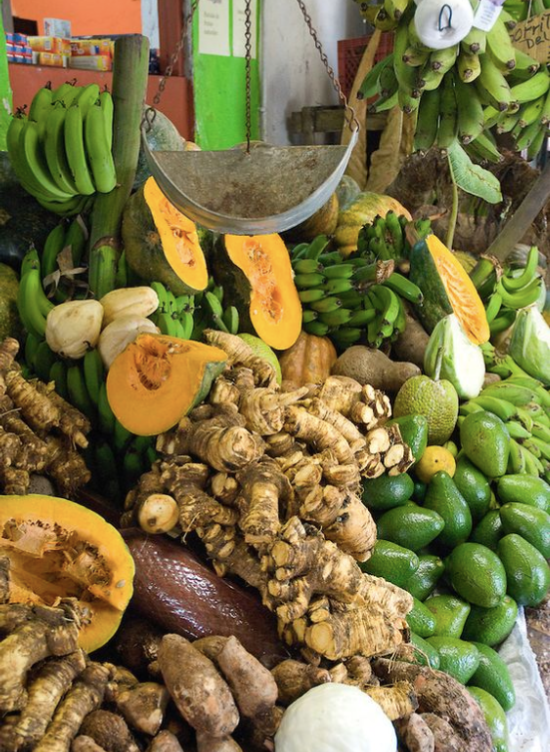Eat your Way through Latin America: Puerto Rico
For Hispanic Heritage Month, the “Eat Your Way through Latin America” series will feature the top five Latin American countries represented on campus at Elon over the course of the next five weeks. Although we recognize that many of us are not of Hispanic heritage, as anthropologists and avid food lovers, we wanted to respect the cultural backgrounds and experiences of our fellow students.
Puerto Rico has a rich history deeply affected by the climate of the island, the imperialism of Spain and relations with the United States. Because of this, its food is a reflection of European, African, American and Caribbean culinary traditions. The Taíno culture, which is that of the indigenous Caribbean islanders, dates back to 1000 A.D. The Taíno people were known for cooking with viandas, which are root vegetables such as ñame, yautía and yucca that are indigenous to Puerto Rico. Before Spanish colonists arrived, the Taíno diet consisted of viandas, corn, birds, fruits, capsicum peppers and seafood. The Taíno people also enjoyed the indigenous fruits of the island, including pineapple, guava, papaya and mamey. Today, these fruits are still enjoyed fresh in Puerto Rico and are often featured in desserts.
Beans are a pre-historic crop that the Taíno planted methodically. They are often included in a sofrito sauce made with tomatoes, cilantro, chili peppers, bell peppers, onions and garlic. Rice and beans can be seen as a side in almost every dish in Puerto Rico. Today, rice is cooked “upwards” or vertically in a pot rather than horizontally, like a paella, which is indicative of African culinary influence, even though rice arrived through the Spaniards.
Along with rice, Spanish colonists introduced livestock, such as pork and chicken, as well as wheat, sugarcane and new vegetables. A love and appreciation of meat in Puerto Rico originated from Spanish colonization. Meat was originally abundant on the island and easy to raise. But at the turn of the 18th century, due to a population explosion, certain communities—including settlers living in rural areas, urban poor, and plantation slaves who were forced to live on a regulated diet—experienced a livestock recession. This made it difficult to continue including meat in their diets. Although this recession hit many homes, meat is still a prominent ingredient in Puerto Rican cuisine.
Pork had the most lasting influence on Puerto Rican cuisine, as it is seen in their national dish of lechón, which is a whole pig marinated in adobo and slow-roasted over coals. Mondongo, or pork cooked with stewed pig tripe and gandinga, which is stewed pig heart, kidneys and liver, are popular dishes as well.
Along with a multitude of new vegetables and livestock, Spanish colonists also brought slaves through the Atlantic Slave Trade. The African people brought to Puerto Rico introduced their traditional cooking techniques to the Puerto Rican people, as well as delivered plantains and bananas, which have become a staple in Puerto Rican dishes. Plantains are considered an iconic food on the island, and is included in dishes such as tostones, piñons and pastelón. They are often fried using African frying techniques. Coconuts also came to the island through the Atlantic Slave Trade, with origins reaching back to Asia. Coconuts are still used to flavor soups, sauces and desserts today in Puerto Rico.
After the Spanish-American War in the late 1800s, Spain ceded Puerto Rico to the United States, giving them a major naval base in the Caribbean. In the 1940s and 50s, Puerto Rico was struggling economically and politically. The poorest communities in the country did not have access to refrigeration and were starving as a result. The United States sent government subsidies as well as supplies in the form of preserved meat to feed these communities. Spam®, corned beef and Vienna sausages were sent as they could be transported and prepared easily. These canned meats altered the course of Puerto Rican cuisine and are still utilized today.
A considerable amount of pride comes with the culinary practices of a country because food often plays a substantial role in national identity. Modern Puerto Rican food is a product of its history through its Taíno roots and native crops, Spanish ingredients like olive oil, pork, and garlic, African deep-frying techniques and 1950s American canned foods. The vibrancy of Puerto Rican culture comes alive through its food, as the traditional dishes are a celebration of flavors that represent its history.
Stay tuned for the next part of the “Eat Your Way through Latin America” series by following @theedgemag!


